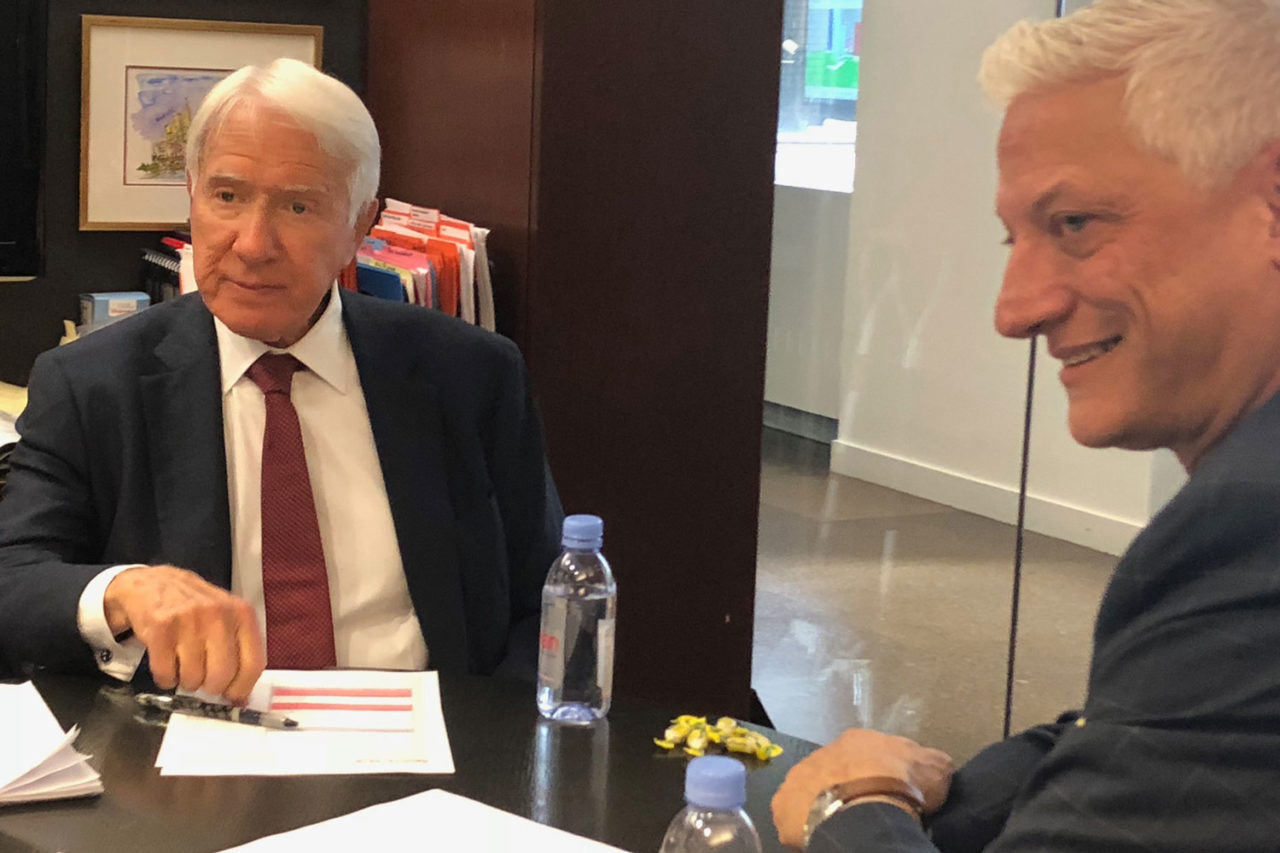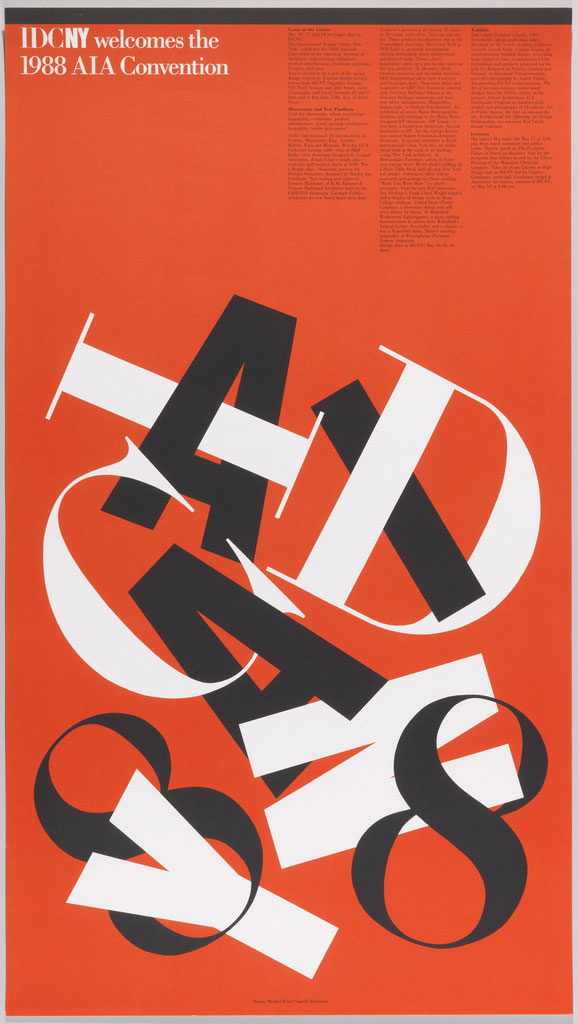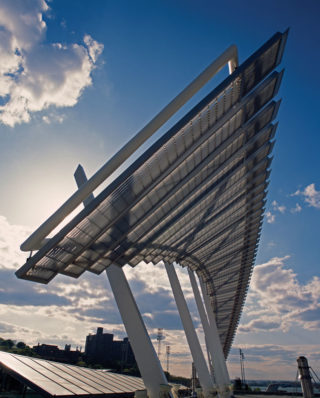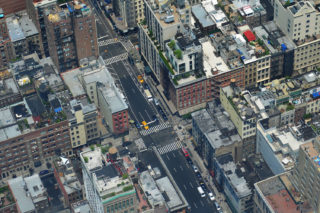


In 1988, A. Eugene “Gene” Kohn, co-founder of Kohn Pedersen Fox, served as AIANY president and helped organize the ’88 AIA National Convention at the newly opened Jacob K. Javits Convention Center. This June, “A’18,” the latest edition of the national conference, returns to New York City after 30 years. To celebrate the occasion, current AIANY President Guy Geier invited Kohn to talk with him about the state of the profession—past, present, and future—in a conversation moderated by writer and editor Clifford Pearson.
Clifford Pearson: Going to the Javits Center in 1988 was a completely different experience than it will be today. How do those changes reflect what’s happening in New York today?
Guy Geier: That’s one of the things we’ve tried to take advantage of this year, with the conference being over there. We’re right in the thick of everything that’s happening at Hudson Yards. The High Line ends right at Javits. Some of the big tours will happen along the High Line. The subway’s 7 line, which terminates across 11th Avenue from Javits, will allow people to get around town more easily. So there’s so much more accessibility from Javits itself, and that will make a tremendous difference.
CP: Gene, back in ’88 when you organized the convention, the theme was “Art in Architecture.” What was the architectural community talking about back then?
Gene Kohn: One of the top events I organized at the time was with Philip Johnson and I.M. Pei. This was 30 years ago, and they were competitive in a lot of things. And Philip, particularly, seemed to hold grudges or be more emotional about stuff. I had arranged a very special event for I.M. to be honored and to give a speech, and I got Philip to come. At first he wasn’t going to come, but I begged him—I mean, really begged him. And I got him to sit right in the front row. He went up and congratulated I.M. and hugged him, and there was enormous applause over these two giants coming together. It was a special evening.
But it was part of what you expected to see at the convention. Many famous architects from all over would come to the events, and so it was an exciting time, at least at the convention. But ’88 was not necessarily an exciting time architecturally, in terms of work. In fact, the late ’80s and almost all of the ’90s was one of the worst periods in New York for doing buildings. The lowest production of buildings was in the ’90s, and the end of the ’80s forecasted that.
CP: I remember all these “see-through” buildings in the early ’90s. They were built in the late ’80s.
GK: That’s right, because in ’88, around the time of the convention, the city made the decision to cut FAR [floor area ratio] on the west side of Midtown by three. The city was trying to avoid all these sites being developed at a 15 or 18 FAR, but it actually drove real estate developers to build before the rules changed. The developers, instead of looking at what the market was demanding at that time, decided they didn’t want to let the FAR go. Which meant they had to design it and get it excavated and up to grade in six months. Not easy to do, but unfortunately, a lot of the developers decided they were not going to lose three FAR. So they started their projects, mostly on Sixth and Seventh Avenues.
And they drove construction prices so high, because contractors had all these buildings they were trying to get done. When they were completed the buildings were empty. Every one of the developers lost the buildings to the insurance companies or the banks that were funding them. So it was a really unfortunate time for the city. We had all these empty buildings, which killed the ’90s.
CP: I started at Record in 1989, so I remember that period. We had our offices on the 41st floor at 1221 Avenue of the Americas, and we looked west and south. I could see a building by SOM, a building by KPF, and a building by Kevin Roche. And they were all 50-story buildings, and they were all…
GK: Empty.
CP: You could look right through them. They were the see-through buildings.
GK: It was an interesting time. So, the convention—while it celebrated a lot of fine architects and accomplishments by the profession, and while there were great parties and all—was at the beginning of a downturn that was major. And if you didn’t go overseas, you were going to be in trouble, unless you did schools or some other kind of institutional buildings.
CP: Postmodernism was waning in ’88, and people were starting to say, “Well, what comes next?”
GG: I’m guessing there was a little more discussion about stylistic and aesthetic issues than we’re seeing today. Technology is a big driver of the conversation now: how we are delivering projects, building technology, construction technology, and all that technology enables us to do.
We’re trying to figure out how architecture can help society, what we can do to improve the social condition, whether it’s sustainability—which we’ve been talking about for a long time—or homelessness, or housing, or resiliency, or infrastructure. All of these issues have risen to a much higher level of consciousness within the profession. My theme for the year, Architect Activist, is all about trying to get more involvement by architects in these issues and leveraging what power we have―I think we have a lot more than we’ve sometimes recognized―to influence public policy and move the needle on these issues.
GK: One minor observation, and I’m not sure it’s worth mentioning, but the dress of architects has changed dramatically in 2018. In fact, when I was in school—I’m a little older than you guys―my heroes were people like Mies van der Rohe, Le Corbusier, and Gropius, and they always wore a suit. Even Lou Kahn wore a bow tie and a rope belt—that’s all he could afford, but he always had a sport coat.
GG: And over the years, the corporate environment has changed. The tech world has driven a lot of that. So now we are just mirrors of that. But, Gene, you and I are still sitting here with our ties and suits on, and I just went to an interview with a suit on. We do what we need to do to address the audience we’re working with.
CP: Right, because it’s about gaining their trust and confidence. If someone’s going to say, “I’m going to give you $350 million to build me a building,” you want to establish a level of trust where they figure…
GK: …you look like you’re going to build it.
CP: It’s ironic that now there are a lot of architects with their offices around Wall Street, where 25 or 30 years ago, architects couldn’t afford to have their offices there.
GG: Our office is currently on 19th Street, but we’re moving to Downtown Brooklyn in three years.
GK [laughing]: Where is that? You’re not joking? Well, that’s interesting. That’s good, though.
CP: Looking towards the future, if AIA decides to pick New York again in 2048, what will New York be like then? What will be the critical issues facing architects?
GK: Well, I think 30 years from now, the economy notwithstanding, those things are impossible to predict. But I do think that environmental issues are going to be major, that they will continue to be a bigger and bigger factor in building and urban design.
And whatever happens with water―sea level change and those sorts of things—it’s going to seriously impact the riverfront here and the neighborhoods inside. So how can we deal with that? We can help, I think, by the way we design our cities and buildings. We can help address the effects of climate change. We really have to get to another level and accept the fact that the change is going to happen, and there’s only so much we can do about it. So it’s really about resiliency and what we do to change our built environment to deal with what’s going to happen.
CP: Do you think most buildings could be Net Zero in 30 years?
GG: I think a lot of them could be. Solar and wind and other renewable solutions will certainly be more and more important as time goes by. But you have to cut the use side as well—you can’t just improve the supply side, you have to improve the utilization side. Buildings have to consume less, and the city needs to consume less.
Finding ways to reduce, whether it’s through Net Zero, Passive House, or whatever it is that gets consumption reduced significantly, that’s going to be the big push between now and 30 years from now. It’s a long forecast, but it’s going to continue to be a big effort that the industry―architects, engineers, builders, everybody―is going to have to deal with.
GK: Our goal is for quality of life. So how can we help? When you see crises in terms of race, religious, and poverty issues, how do you design cities that promote unity, cooperation, and a spirit of providing care for the poor and making sure people have at least a decent basic quality of life―not living on the sidewalk, not wanting for proper food—and dealing with issues of crime and all? Architects need to recognize that they can play a greater role in creating environments that are conducive to the quality of life we want.










